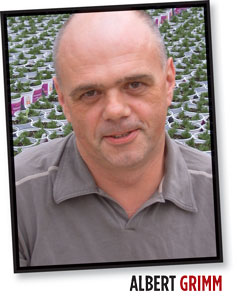9/15/2010
Growers Talk Production: Connecting the Dots
Albert Grimm

Every year in late spring, we offer students from our horticulture college an opportunity to get their feet wet and their hands dirty (quite literally). The school term ends just when we get busy with spring shipping, and so it’s not until early June that we have enough time for dedicated training. By then, most of our newcomers have been somewhat traumatized by the madness of spring in a bedding plant greenhouse. In fact, some of the students may begin to wonder if greenhouse work was really such a good career choice after all.
But even amidst this chaos, it dawns on them that the daily work of a grower has surprisingly little to do with “making plants grow.” Plants appear to grow perfectly well without our help. Greenhouse work does involve a lot of watering and fertilizing, but the prospect of employment as a water clerk hardly creates excitement for anyone who has just spent two years studying plant physiology and life sciences, and is eager to apply that knowledge in a meaningful way.
Plants, however, show a stubborn failure to acknowledge such good education. This observation causes confusion among the students, but it also generates questions. Every time a student asks us about the true nature of our work, it’s an opportunity for us to inspire passion into this next generation of growers. It’s important that we make an honest effort to answer these questions thoughtfully. If we get it right, we can open a window into a world of knowledge and opportunity that is invisible to most people outside horticulture.
And this is our answer: “A good grower does not grow plants. A good grower controls plant growth.” Making plants grow is rather easy; we don’t have to contribute all that much. Controlling growth is a different story. It’s a bit like taming wild animals. As growers we need to be in charge of the plant. We have to break the will of the crop, and change its behavior to our bidding. We do so by tweaking nature. This isn’t easy and requires us to engage many disciplines of science. It also requires us to learn the “habits” of plants by observing them year after year. We need to learn the language of nature to be effective.
In a greenhouse, we can control the size and the habit of plants. We can control the time of flower, and we can control the ratio of flowers to foliage. We can also improve plant health and post-production performance of our crops, and in doing so create better markets for our industry and happier consumers.
Our tools include water and nutrients: We can keep our crops either happy or hungry or thirsty. We also control temperature and water loss experienced by the crop. We control light energy, light quality and raw materials (CO2) that are available to the crop. Through the use of “medication” we can optimize the hormone balance in the plant.
For some of our students, the boredom of daily watering quickly fades into feeling overwhelmed with details. And when that moment arrives, we can really start training them. I try to help them with this analogy: Remember the dot-to-dot puzzles we played as kids, just sheets full of dots and numbers? First you connect the dots numbered 1 and 2 with a line. Then you continue drawing lines to each successive higher number. At some point, the chaos of numbers, dots, and lines suddenly emerges into a recognizable drawing.
Becoming a grower is a similar experience, albeit much slower. After years of collecting random bits of experiences and knowledge, rather suddenly a picture emerges from seemingly unrelated details. Once that happens, much of our work begins to make sense, and every new detail that we collect renders the picture more complex and more rewarding.
Our junior growers will experience this, as long as we help them to connect the dots for the first few years, and encourage them to be patient and wait for the bigger picture to emerge. They need our help. If this is not something that we can teach them, then who will?
GT
Albert Grimm is head grower for Jeffery’s Greenhouses in St. Catharines, Ontario, Canada.